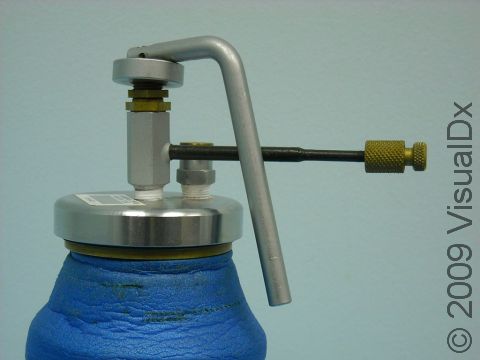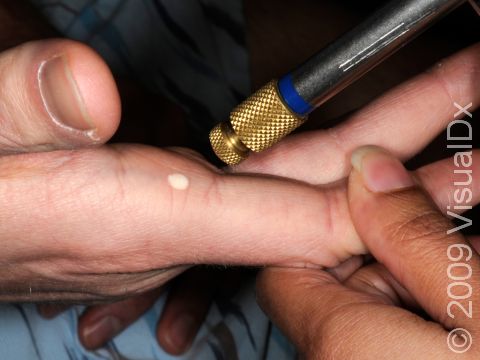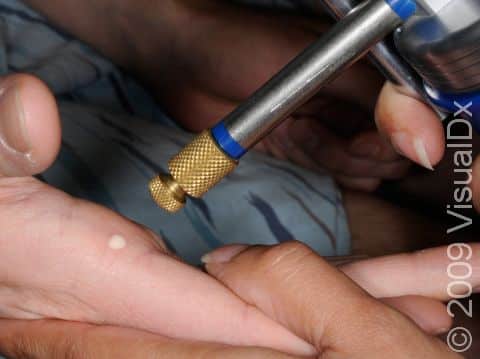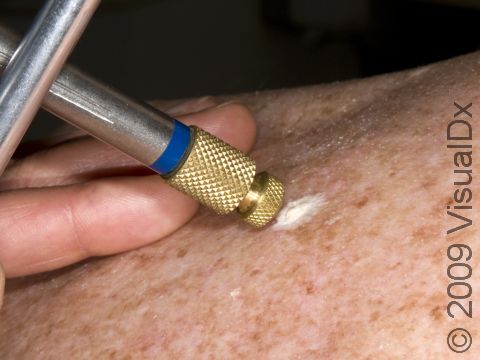Cryosurgery
Cryosurgery, also known as cryotherapy or cryoablation, commonly uses liquid nitrogen or another extremely cold liquid to destroy abnormal tissue, such as noncancerous, precancerous, and some cancerous skin lesions.
Many skin growths can be safely treated by a medical professional such as a dermatologist with cryosurgery. Warts, skin tags (acrochordons), and premalignant lesions related to chronic sun exposure (known as actinic keratoses) are some of the lesions commonly treated with cryosurgery. Certain types of superficial skin cancers (eg, superficial basal cell carcinoma) can also effectively be treated with cryosurgery.
One of the major advantages of this simple, low-risk procedure is that it can be done during an in-office visit.
What to Expect During Your Visit
For small lesions, liquid nitrogen can be applied using a cotton-tipped applicator or with a spray in less than 10 seconds. Warts may require 2 cycles of 10-15 seconds each; the second cycle is given after the frozen area has thawed. Larger lesions may require longer freezing cycles, and superficial basal cell carcinomas may require repeat freezing cycles that last for 30-60 seconds. People may experience temporary burning pain during the treatment and for up to a minute thereafter.
What to Expect After Your Visit
Following cryosurgery, there may be some swelling at the treatment site, as well as mild pain or itching, which will improve within hours. Blistering may also occur within hours of treatment. Then, the treated area of skin will start to dry up and become scaly. Finally, the area may scab and fall off within 7-14 days.
Follow-Up Care
Petrolatum jelly (eg, Vaseline) or antibiotic ointment can be applied to larger lesions to protect the site from developing an infection, but this is usually not necessary for smaller lesions. Gentle cleansing with water and soap is recommended. If desired, the treated area can be covered with a bandage or dry gauze (changing the dressing daily) until it heals.
If a blister forms, keep it clean and do not attempt to pop it. The blister will eventually shrink or may drain on its own. If the blister pops, do not remove the skin, as it acts as a protective barrier.
Risks and Potential Side Effects
Skin discoloration of the area (usually decreased pigment known as hypopigmentation or complete loss of pigment known as depigmentation) may occur in the days or weeks following cryosurgery. It can be permanent in some cases or slowly fade away after a few weeks to months. Hypopigmentation or depigmentation following cryosurgery is particularly common in people with darker skin colors.
An infection is rare but is possible if a blister has formed and bacteria enters through a break in the blister.
When to Seek Medical Care
If you have large, tense blisters that are painful following cryosurgery, see your medical professional, who can properly drain blisters in their office.
See your medical professional if you see signs of infection, such as pain, spreading redness, or fever.
Sometimes cryosurgery is only partially successful in removing a lesion, and your medical professional may schedule a follow-up appointment to ensure the treatment was successful.
References
Clebak KT, Mendez-Miller M, Croad J. Cutaneous cryosurgery for common skin conditions. American Family Physician. 2020;101(7):399-406.
NCI. Cryosurgery to treat cancer. National Cancer Institute. https://www.cancer.gov/about-cancer/treatment/types/surgery/cryosurgery. Updated 2021 Jun 21. Accessed 2024 May 3.
Last modified on May 14th, 2024 at 10:37 pm

Not sure what to look for?
Try our new Rash and Skin Condition Finder



